
Snow-covered houses and the downtown skyline in Vancouver on Dec. 30, 2021.DARRYL DYCK/The Canadian Press
Ottawa’s next push on “green homes” is to require energy-efficiency ratings for houses going on the market – a controversial approach that sits at the nexus of hot-button issues in the country: climate change and real estate.
Officials in the Department of Natural Resources are working on a proposal for mandatory energy-performance audits of residential homes before the point of sale. This would require the buy-in of the provinces and territories, which have jurisdiction over the sale and development of real estate.
If such initiatives in other countries are any indication, homeowners would have to post their property’s energy-efficiency rating on their listing. International research shows that higher energy-performance scores are correlated with increased property values.
Time-of-sale labelling is part of the federal government’s blueprint to achieve net-zero emissions from buildings by 2050. It’s effectively the policy companion to the Canada Greener Homes Grant program, which helps homeowners cover the costs of investments in energy-conserving improvements such as electric heat pumps and better attic insulation.
The Liberals have had energy-performance labelling on their radar for years, and the party highlighted it as a platform commitment during last fall’s federal election.
Prime Minister Justin Trudeau has since made clear that compulsory labelling for homes at the time of sale is a priority for his re-elected government. Last month, he updated the Natural Resources ministerial mandate letter to include mandatory efficiency labelling under the federal EnerGuide ratings system.

WHAT ENERGUIDE ENERGY-EFFICIENCY
HOME EVALUATIONS SHOW
1
2
3
5
4
6
Rating of the home’s energy consumption
1
Compares the home’s performance with a benchmark home
2
The lower the number on the scale, the better the home’s energy performance
3
Shows breakdown of energy consumed by source
4
Shows breakdown of the home’s annual energy consumption
5
Shows the home’s greenhouse-gas
emissions
6
SOURCE: NATURAL RESOURCES CANADA

WHAT ENERGUIDE ENERGY-EFFICIENCY
HOME EVALUATIONS SHOW
1
2
3
5
4
6
Rating of the home’s energy consumption
1
Compares the home’s performance with a benchmark home
2
The lower the number on the scale, the better the home’s energy performance
3
Shows breakdown of energy consumed by source
4
Shows breakdown of the home’s annual energy consumption
5
Shows the home’s greenhouse-gas emissions
6
SOURCE: NATURAL RESOURCES CANADA

WHAT ENERGUIDE ENERGY-EFFICIENCY HOME EVALUATIONS SHOW
Compares the home’s performance with a benchmark home
Rating of the home’s energy consumption
The lower the number on the scale, the better the home’s energy performance
Shows breakdown of the home’s annual energy consumption
Shows the home’s greenhouse-gas emissions
Shows breakdown
of energy consumed by source
SOURCE: NATURAL RESOURCES CANADA
In an interview with The Globe and Mail, Natural Resources Minister Jonathan Wilkinson said Canada must make progress on greening the buildings sector, which accounts for 13 per cent of the country’s greenhouse-gas emissions. Given that approximately 70 per cent of current building stock will still exist in 2050, compulsory labelling, Mr. Wilkinson said, should apply to both new and existing homes.
“It will help buyers in terms of understanding the energy costs they’re going to pay,” he said. “It will help increase the literacy around energy and energy usage. It also creates an incentive for homeowners to improve their energy efficiency if, in fact, they want to sell.”
Some form of mandatory energy-efficiency labelling has been commonplace across much of Europe for more than a decade. Several U.S. cities have a version of a residential rating program, as does a territory in Australia. But the prospect of adding another step to the sale process here in Canada is eliciting opposition from within the real estate industry, especially amid the country’s tight housing market.
“Mandating labelling at the time of sale is, quite frankly, a crazy thing to do in the middle of a historic housing-affordability crisis,” said Matthew Thornton, the vice-president of public affairs and communications for the Ontario Real Estate Association (OREA).
“We have historic lows in inventory listings on the market currently. Another piece of red tape on a home seller will depress listings even more, making it even more costly to go find a home.”

HOW A HOME’S ENERGY EFFICIENCY
CAN BE IMPROVED
1
1
2
3
4
5
6
6
3
8
7
Better insulation in the walls, attic and basement
1
Energy Star-certified fluorescent or LED light bulbs
5
A programmable thermostat
2
High-performing Energy Star-certified windows and doors
6
Energy Star-certified appliances and heating and cooling equipment
3
Programmable power strips for electronics
7
Low-flow water-saving toilets, showerheads and faucets
Energy Star-certified exhaust fans for bathrooms and kitchen
4
8
MURAT YÜKSELIR / THE GLOBE AND MAIL, SOURCE: NATURAL RESOURCES CANADA; THE CANADIAN REAL ESTATE ASSOCIATION

HOW A HOME’S ENERGY EFFICIENCY
CAN BE IMPROVED
1
1
2
3
4
5
6
6
3
8
7
Better insulation in the walls, attic and basement
1
Energy Star-certified fluorescent or LED light bulbs
5
A programmable thermostat
2
High-performing Energy Star-certified windows and doors
6
Energy Star-certified appliances and heating and cooling equipment
3
Programmable power strips for electronics
7
Energy Star-certified exhaust fans for bathrooms and kitchen
Low-flow water-saving toilets, showerheads and faucets
8
4
MURAT YÜKSELIR / THE GLOBE AND MAIL, SOURCE: NATURAL RESOURCES CANADA; THE CANADIAN REAL ESTATE ASSOCIATION

HOW A HOME’S ENERGY EFFICIENCY CAN BE IMPROVED
1
1
2
3
4
5
6
6
3
8
7
Better insulation in the walls, attic and basement
Programmable power strips for electronics
Low-flow water-saving toilets, showerheads and faucets
1
4
7
Energy Star-certified exhaust fans for bathrooms and kitchen
A programmable thermostat
Energy Star-certified fluorescent or LED light bulbs
5
8
2
Energy Star-certified appliances and heating and cooling equipment
High-performing Energy Star-certified windows and doors
6
3
MURAT YÜKSELIR / THE GLOBE AND MAIL, SOURCE: NATURAL RESOURCES CANADA; THE CANADIAN REAL ESTATE ASSOCIATION
But when it comes to cost, it may pay to go green. Daniel Daly, a research fellow with the Sustainable Buildings Research Centre at the University of Wollongong in Australia, co-conducted a review of international research on mandatory energy-efficiency labelling programs to determine the effect of disclosure on property values.
“Of the 27 studies we looked at, the vast majority reported there was a statistically significant price premium associated with energy efficiency,” he said. The price premium was typically in the order of 5 to 10 per cent.
Certain provinces and territories in Canada will inevitably be more supportive of time-of-sale labelling than others. In B.C., several municipalities have already experimented with voluntary labelling programs, in co-operation with B.C. Hydro and the provincial energy ministry.
The idea is also referenced in the B.C. Finance Minister’s mandate letter, which refers to requiring realtors to “provide energy-efficiency information on listed homes to incent energy-saving upgrades and let purchasers know what energy bills they will face.”
In Ontario, however, there are bound to be hurdles. Under the 2009 Green Energy Act, a provincial Liberal government had planned to require time-of-sale energy audits, but the idea never got off the ground.
While the Ontario Home Builders’ Association (OHBA) welcomed mandatory labelling, the real estate association mounted a campaign to stop it, saying the requirements would complicate the sale process and punish low-income families who can’t afford retrofits. Realtors were also concerned that the quality and findings of the audits could vary wildly from one adviser to the next.
Premier Doug Ford’s Progressive Conservative government repealed the Green Energy Act in 2019, and the proposed Home Energy Rating & Disclosure initiative died with it.
Brendan Haley, director of policy research for think tank Efficiency Canada, said although movement toward mandatory labelling “really stalled for a while,” momentum is now growing. “It’s just an obvious thing to do, given that we have to retrofit basically all of our buildings by 2050, if not before,” he said.
Canadian jurisdictions contemplating mandatory labelling initiatives have many models to look to for inspiration, particularly in Europe. Since 2009, European Union member states have been required to comply with a 2002 directive that says countries must introduce energy-performance certificates for buildings that are newly constructed, sold or rented.

A new home is built in a housing development in Ottawa on July 14, 2020.Sean Kilpatrick/The Canadian Press
Most member states started by issuing certificates for new residential buildings, and then at a later stage, extended the requirement to existing homes and, in some cases, public and commercial buildings. The European Commission is now proposing to go a step further by triggering mandatory renovations of existing buildings if minimum energy-performance standards aren’t met.
OHBA president Bob Schickedanz said the association is still supportive of energy-efficiency labelling for homes going on the market. Houses built today, he said, use about half the energy of those constructed roughly 30 years ago. He said the EnerGuide audits would be especially useful after a sale, since the buyer would receive a menu of potential upgrades that would reduce energy use and costs.
The Canadian Real Estate Association said it will be in touch with federal officials “in the coming weeks” about the prospect of mandatory time-of-sale labelling. In an e-mail, spokesperson Pierre Leduc said the association supports efforts to improve energy efficiency, but not at the cost of a reduced housing supply.
“Canada is facing a historic supply shortage, and the government will need to manage the twin goals of vastly increasing housing supply while working toward meeting climate-change commitments,” he said.
In addition to jurisdictional issues and concerns over housing inventory, mandatory labelling would require a massive recruitment of energy advisers who could perform the presale audits under the EnerGuide system.
Already, homeowners are frustrated by a shortage of certified advisers, as demonstrated by problems with the rollout of the Greener Homes program. The initiative provides homeowners with as much as $5,600 for upgrades and the requisite pre- and post-retrofit EnerGuide evaluations. Some homeowners have been told it could be months or even years before an energy adviser would be available.
Mr. Wilkinson said the government didn’t foresee how popular the Greener Homes program would be (within three days of its launch, more than 32,000 applications were submitted). “Had we known that,” he said, “perhaps we would have made sure we had put additional resources in place before the launch.”
Two weeks before the program opened, the government announced that it would invest $10-million to recruit and train an additional 2,000 federally certified energy advisers. At present, the majority of the existing 1,250 advisers are located in Ontario, Quebec and B.C. In several provinces and territories, there are fewer than 15 serving the entire jurisdiction.
The Canadian Association of Consulting Energy Advisors said it is confident that the energy-auditing industry could meet the demand associated with mandatory time-of-sale labelling if given the time to do so.
“The industry is at a place where it can be done,” said Andrew Oding, vice-president of the association’s board of directors. “The profession is exploding.”
Your time is valuable. Have the Top Business Headlines newsletter conveniently delivered to your inbox in the morning or evening. Sign up today.